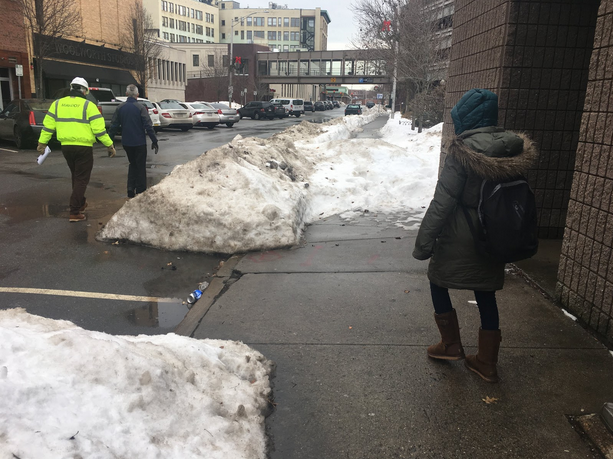With spring approaching, the Boston City Council convened a public hearing on Tuesday morning to consider increasing the city government's responsibilities in keeping sidewalks clear and accessible after snowstorms.
Councilor Kenzie Bok, who represents Back Bay and Mission Hill, requested the hearing before the Council's Committee on City and Neighborhood Services after a large Nor'easter last December left some of her constituents housebound for days.
"In the days after (the storm) I heard a lot from pedestrians and folks who get around our city by foot and by wheel on the sidewalks… So this hearing order really came out of an interest in looking at how we can be a bit more systematic about prioritizing pedestrian needs to get around the city – to access groceries, visit family, go to the store – and really think about how our systems could be improved on that front."
Current laws theoretically delegate responsibilities for sidewalk snow clearance to abutting property owners, with enforcement by the city's code enforcement officers.
Under these rules, the city itself is already responsible for the many sidewalks abutting its parks, schools, and other facilities; the city also takes responsibility to clear sidewalks on city-controlled bridges.
But because the current system disperses snow-clearing responsibilities among thousands of different people, even some of the city's busiest sidewalks can be effectively impassable for days following large storms.
Meanwhile, roadways for motor vehicles are cleared almost immediately, at considerable expense to the city.
At Tuesday's hearing, Corey Driscoll Dunham, the Chief Operating Officer of Syracuse, New York, outlined an alternative approach.
In 2018, Syracuse took over sidewalk snow clearance responsibilities for 20.1 miles of city streets, based on a prioritization framework focused on pedestrian safety and accessibility. The program was expanded to 38 miles of streets in 2019 before being suspended this year because of pandemic-related budget cuts. The city plans to resurrect the program next winter with a new dedicated fund collected from abutting property owners.
"We considered enhanced enforcement with more ticketing," said Driscoll Dunham, "But it's very staff intensive to have someone take a call, send out an inspector, do the inspection, issue a ticket, follow up... it's just very resource-heavy."
Kristiana Lachiusa, Director of Transit and Outreach for the LivableStreets Alliance, endorsed the Syracuse approach in subsequent testimony.
"Boston (calls itself) an age-friendly community," Lachiusa reminded the Council. "We have a requirement – we made an agreement – that we were going to do this, so we need to keep up our end of the bargain.”
City councilors said that the committee would host another working session later this year to discuss the Syracuse model further.
"What we spend city money on and what we see as our responsibility to do as a city is a question of policy prioritization," said Bok.
Sidewalk snow removal "needs to be part of the basic provision of city services... Sidewalks are the essential infrastructure that people are going to use to get around.”

